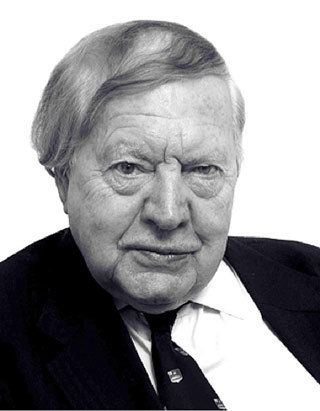Name Noel Hush | ||
 | ||
Professor Noel Sydney Hush AO, DSc, FRS, FNAS, FAA, FRACI, FRSN is an Australian chemist at the University of Sydney.
Contents
Career
Hush was born in Sydney on 15 December 1924 and obtained his degrees (BSc Hons (1945) and MSc (1948)) at the University of Sydney, where he worked as a Research Fellow in the Department of Chemistry (1945–49). He then accepted an invitation from M. G. Evans FRS to work in England as an Assistant Lecturer at the University of Manchester (1950–54) in the department created by Michael Polanyi. He was subsequently Lecturer and then Reader in the Department of Chemistry at the University of Bristol (1955–71).
He then returned to Australia in 1971 to found The Department of Theoretical Chemistry at the University of Sydney, the first such department in Australia. This rapidly became established as a centre for excellence in teaching, from undergraduate to postdoctoral level, and research. In 1989 he became Emeritus Professor engaged in full-time research. He has also held numerous prestigious visiting scientist positions at universities in Australia, the United Kingdom and the United States of America.
Adiabatic Electron Transfer
A unifying theme of Hush’s research is elucidation of chemical electron transfer. This is the basis of oxidation-reduction processes, which are ubiquitous in Nature in both the inorganic and biological spheres. The mechanism of these reactions - the simplest of which proceed without making or breaking chemical bonds - remained unknown until the mid nineteen-fifties, when several independent theoretical studies showed that it was due to modulation of coupling between electronic and vibrational motions. According to his Royal Society election citation, Hush’s research in the area of homogeneous and heterogeneous electron transfer showed that electron transfer occurring during a collision between a molecule and either another molecule or else an electrode surface occurs adiabatically on a continuous potential-energy surface, and that electron transfer can occur by either optical or thermal mechanisms with the corresponding rates being closely connected.
Figure 1 sketches the basic elements of adiabatic electron-transfer theory. Two chemical species (ions, molecules, polymers, protein cofactors, etc.) labelled D (for “donor”) and A (for “acceptor”) become a distance R apart, either through collisions, covalent bonding, location in a material, protein or polymer structure, etc. These species have different chemical bonding environments and they polarize any surrounding condensed media. A key feature is that both species must be able to sustain different charge (valence) states. Electron-transfer theories specify equations describing the rate of charge transfer processes that utilize these different charged states. All electrochemical reactions occur by this mechanism. Adiabatic electron-transfer theory stresses that intricately coupled to such charge transfer is the ability of any D-A system to absorb or emit light. Hence fundamental understanding of any electrochemical process demands simultaneous understanding of the optical processes that the system can undergo.
Figure 2 sketches what happens if light is absorbed by just one of the chemical species, taken to be the charge donor. This produces an excited state of the donor. As the donor and acceptor are close to each other and surrounding matter, they experience a coupling
Unifying standard electrochemical electron-transfer processes with this type of solar energy harvesting, adiabatic electron-transfer theory also depicts a third application in which the donor and acceptor are both involved in light absorption, as sketched in Figure 3. Here, light absorption directly leads to charge separation D+-A- . Hush’s theory for this process considers the donor-acceptor coupling
This theory explained how the worlds first modern synthetic dye, Prussian blue absorbes light, creating the field of intervalence charge transfer spectroscopy.
Hush’s theory also provides theoretical underpinning for the Robin-Day classification system for mixed-valence systems. Mixed valence is widespread in chemistry, from superconductors to minerals, magnetic molecular clusters and enzymes. It occurs when the same chemical species is found in two formally different oxidation states in the same system.
The synthesis of the mixed-valence Creutz-Taube ion, an event leading significantly to the award of the 1983 Nobel Prize in Chemistry to Henry Taube, demonstrated the successfulness of adiabatic electron-transfer theory. In this molecule, the coupling
Adiabatic electron-transfer theory stems from London’s approach to charge-transfer and indeed general chemical reactions applied by Hush using parabolic potential-energy surfaces. Hush himself has carried out many theoretical and experimental studies of mixed valence complexes and long range electron transfer in biological systems. Hush’s quantum-electronic adiabatic approach to electron transfer was unique; directly connecting with the Quantum Chemistry concepts of Mulliken, it forms the basis of all modern computational approaches to modeling electron transfer. Its essential feature is that electron transfer can never be regarded as an “instantaneous transition”; instead, the electron is partially transferred at all molecular geometries, with the extent of the transfer being a critical quantum descriptor of all thermal, tunneling, and spectroscopic processes. It also leads seamlessly to understanding electron-transfer transition-state spectroscopy pioneered by Zewail.
In adiabatic electron-transfer theory, the ratio
In the weak-coupling (“non-adiabatic”) limit, the activation energy for electron transfer is given by the expression derived independently by Kubo and Toyozawa and by Hush. Using adiabatic electron-transfer theory, in this limit Levich and Dogonadze then determined the electron-tunneling probability to express the rate constant for thermal reactions as
This approach is widely applicable to long-range ground-state intramolecular electron transfer, electron transfer in biology, and electron transfer in conducting materials. It also typically controls the rate of charge separation in the excited-state photochemical application described in Figure 2 and related problems.
Marcus showed that the activation energy in Eqn. (3) reduces to
Adiabatic electron-transfer theory is often also widely applied[2] in Molecular Electronics. In recent years it has been generalized to arbitrary chemical reactions, providing a single conceptual basis covering many different aspects of chemical research. In particular, this reconnects adiabatic electron-transfer theory with its roots in proton-transfer theory and hydrogen-atom transfer, leading back to London’s theory of general chemical reactions. In this approach, most chemical processes can be depicted in terms of the three critical parameters
